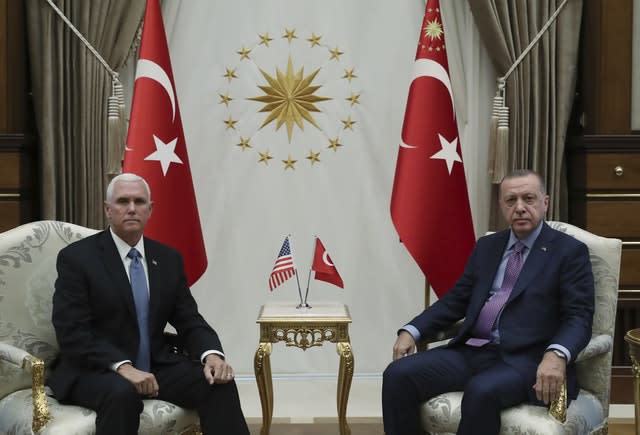Fighting continues in Syria despite US-brokered ceasefire
Fighting is continuing in and around a north-eastern Syrian border town at the centre of the fight between Turkey and Kurdish forces, despite a US-brokered ceasefire that came into effect overnight.
The town of Ras al-Ayn, scene of some of the fiercest fighting of the Turkish invasion, was emerging as an immediate test for the five-day ceasefire agreed by Washington and Ankara.
Before the deal was announced, Turkish-backed forces had encircled the town and were battling fierce resistance from Kurdish fighters inside.
A spokesman for the Kurdish-led fighters said they were not withdrawing because Turkish forces are still besieging and shelling the town. Elsewhere along the border, calm seemed to prevail.
#SOHR #Ankara-loyal factions attack #SDF in #Ras_al_Ayn ( #Sari_Kani ) city in conjunction with targeting the medical convoy that try to enter the city to evacuate the wounded and injured https://t.co/MxjZqOBWD1
— #المرصدالسوري #SOHR (@syriahr) October 18, 2019
The Britain-based Syrian Observatory for Human Rights and the Rojava Information Centre said fighting continued into the afternoon as Turkish-backed Syrian fighters clashed with Kurdish forces in villages on the outskirts of Ras al-Ayn.
The Kurdish-led force said five of its fighters were killed and a number of civilians wounded in a Turkish air strike on one of the villages.
Other activists reported a new exodus of civilians from the villages. Gun battles and shelling continued around a hospital in the centre of Ras al-Ayn, and injured inside could not be evacuated, said Mustafa Bali, spokesman for the Kurdish-led Syrian Democratic Forces.
The Kurdish Red Crescent said it was unable to enter the town to evacuate wounded because of fighting.
Turkish President Recep Tayyip Erdogan denied any fighting took place on Friday and said Kurdish fighters had begun withdrawing.

Mr Bali said that was not true: “The Turkish land and air bombing continue in Ras al-Ayn.”
The ceasefire agreement — reached after hours of negotiations in Turkey’s capital between Mr Erdogan and US vice president Mike Pence — requires the Kurdish fighters to vacate a stretch of territory in Syria along the Turkish border. That arrangement would largely solidify the position Turkey has gained after days of fighting.
The Turks and the Kurds appear to disagree on the size of the area covered by the ceasefire. Turkey calls it a “pause” not a ceasefire.
It remains unclear if the Kurdish-led force was on board with pulling back even if a pause in fighting takes hold.
Mr Pence said the US was already co-ordinating with it on a withdrawal, but American sway with the group has diminished after President Donald Trump turned his back on it by withdrawing US soldiers from north-east Syria, opening the way for Turkey to launch its invasion 10 days ago.
The Kurdish-led force’s commander, Mazloum Abdi, said on Thursday night that it would abide by the ceasefire and “do our best to make it successful”. He did not mention any withdrawal.
A member of the Syrian Kurdish force ruled out any pullback from border towns, calling the US deal with Turkey an “insult” and saying “no way this will work”.
“They think we will just leave our land and our people to Turks if we are asked,” he said. “They can come and take the land by force. Nobody should expect us to leave our land.”
“How does the US think to enforce a deal without presence on the ground?”

 Yahoo News
Yahoo News 
